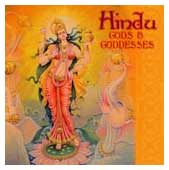 |

|
|
HINDU - PANTHEON OF GODS
THE MAHADEVAS
Approximately six forms of godheads are worshipped
in India today. Apart from the Vaishnavas’ Vishnu, Shaivites
Shiva and Shakta’s Devi there are three more godheads
that are adored. Sauras worship Surya, Ganapatyas worship Ganesha
and Kaumaryas treat Skanda (Muruga in the Tamil lands), as their
godhead. Collectively these six forms of divine worship of Hindus
are called as Shanmatas.
However, other gods are worshipped with their own temples and are
numerous all over the country. Each god has a special function to
perform, be it protection of a certain sect or to bring good luck
and wealth to the worshipper.
Each god has a particular power associated with him
which, in turn, is represented as a consort. Although talked about
as though the consorts were wives, some say there are no genders to
the gods. The Creator, Brahma, has as his consort,
Saraswati, goddess of speech and learning. Protector
Vishhnu's consort is Lakshhmi, goddess of wealth and
prosperity, and Destroyer Shiva's consort is Shakti,
goddess of power. These gods in turn have their own attendants,
vehicles, incarnations, and even animals; hence, the large
pantheon of Hindu deities, the Mahadevas. |

WORLD RELIGIONS
COMPARED
WORLD
RELIGIONS CLIPART
WORLD
RELIGIONS HOME
HINDUISM HOME
HINDU GODS |
You might say this is a partial list of the leftover
gods! Important nevertheless in Hindu tradition and too many in
number to ever count..
 |
AGNI: The Hindu god of fire and guardian of humanity. He is
the fire of the sun, of lightning, and of the hearth of
worship, and is the divine personification of the fire
of sacrifice. He is thus the messenger between human and
divine orders. Agni is described as ruddy-hued and with
two faces, one beneficent and one malignant.
|
 |
ASHWINI (ASVIN KUMARS):
Twin sons of Vivaswat and Saranyu, They
were celebrated as 'divine physicians' of Vedic period.
Rig Veda abounds in citations of their medical skill and
benevolent deeds. Their skill in therapeutics and
surgery is the theme of more than 50 hymns of Rig Veda.
They were celebrated for the skill of restoring youth to
old, curing the sick, weak, blind and the lepers.
|
 |
BALARAMA: Elder brother of Krishna.
|
 |
GANESHA (GANESH):
With his elephant head and four hands, he has power over
civil matters. Many business people keep his image as an
emblem of protection.
|
 |
HANUMAN: The child
of a nymph by the wind god; accompanied by a host of
monkeys, he aided Rama in recovering his wife, Sita,
from the demon Ravana. Hanuman is the only character
that appears in both the Hindu epics, the Ramayan
and the Mahabharat, which are spread across
millennia.
|
 |
INDRA: Regarded as the
generous bestower of sons, riches, houses, and various
pleasures. He is the god of thunder.
|
 |
LALITA (SHODASHI / TRIPURA SUNDARI):
Extraordinarily beautiful and forever young. She is the
fountain of beauty and inspiration. In her hands she
holds a sugarcane bow, representing the mind; arrows
represent the sense organs which shoot like arrows
through the mind and sense objects. |
 |
SOMA: The god of the
moon. In the Vedas, Soma is portrayed as
sacred and as a god (deva). The god, the drink and the
plant probably referred to the same entity, or at least
the differentiation was ambiguous. In this aspect, Soma
is similar to the Greek ambrosia (cognate to amrita); it
is what the gods drink, and what made them deities.
|
 |
SURYA: The god of the
sun. Surya is a special god who dwelt in the body of the
sun, and is described as the husband of dawn. He is also
the guardian of the southwest quadrant. His father is
the sky god Dyaush or Indra. One myth tells how he arose
from the eye of the world-giant, Purusa. Surya has
golden hair and golden arms. He drives in a chariot
drawn by a team of 4 or 7 horses.
|
I honor the God and the Goddess,
the eternal parents of the universe.
Jnaneshwar

| |
 |
 |

